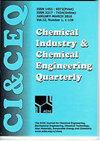化学工程方法在分析三维癌细胞培养:流体力学和质量运输的考虑
IF 0.8
4区 工程技术
Q4 CHEMISTRY, APPLIED
Chemical Industry & Chemical Engineering Quarterly
Pub Date : 2021-01-01
DOI:10.2298/ciceq210607033r
引用次数: 1
摘要
基于实验和数学建模的多学科方法被用于癌细胞三维(3D)培养的仿生系统开发。具体而言,将人胚胎畸胎癌NT2/D1和大鼠胶质瘤C6两种癌细胞分别固定在海藻酸微珠和微纤维中,在灌注生物反应器中静态和流动条件下培养,并应用化学工程方法解释所得结果。表面介质流速为80 mm s-1时,表面微珠区NT2/D1细胞活力降低,表明流体剪切应力的不利影响约为~67 mPa。相反,与静态对照相比,相似的速度(100 mm s-1)增强了微纤维内C6胶质瘤细胞的增殖。另外对银/蜂蜜/海藻酸盐纳米复合微纤维在灌注下的银释放进行了研究,发现介质部分流过水凝胶(间隙速度为~10 nm s-1)。因此,采用扩散-平流-反应模型来描述物质在微纤维内向固定细胞的转移。扩散系数为- 10-9-10-11 m2 s-1的物质仅由扩散供给,而扩散系数明显较低的物质(?10-19 m2 s-1)需要额外的对流输送。本研究展示了化学工程方法在肿瘤模型系统开发中的选择和贡献。本文章由计算机程序翻译,如有差异,请以英文原文为准。
Chemical engineering methods in analyses of 3D cancer cell cultures: Hydrodinamic and mass transport considerations
A multidisciplinary approach based on experiments and mathematical modeling was used in biomimetic system development for three-dimensional (3D) cultures of cancer cells. Specifically, two cancer cell lines, human embryonic teratocarcinoma NT2/D1 and rat glioma C6, were immobilized in alginate microbeads and microfibers, respectively, and cultured under static and flow conditions in perfusion bioreactors, while chemical engineering methods were applied to explain the obtained results. The superficial medium velocity of 80 mm s-1 induced lower viability of NT2/D1 cells in superficial microbead zones implying adverse effects of fluid shear stresses estimated as ~67 mPa. On the contrary, similar velocity (100 mm s-1) enhanced proliferation of C6 glioma cells within microfibers as compared to static controls. An additional study of silver release from nanocomposite Ag/honey/alginate microfibers under perfusion indicated that medium partially flows through the hydrogel (interstitial velocity of ~10 nm s-1). Thus, a diffusion-advection-reaction model was applied to describe the mass transport to immobilized cells within microfibers. Substances with diffusion coefficients of ?10-9-10-11 m2 s-1 are sufficiently supplied by diffusion only, while those with significantly lower diffusivities (?10-19 m2 s-1) require additional convective transport. The present study demonstrates the selection and contribution of chemical engineering methods in tumor model system development.
求助全文
通过发布文献求助,成功后即可免费获取论文全文。
去求助
来源期刊

Chemical Industry & Chemical Engineering Quarterly
CHEMISTRY, APPLIED-ENGINEERING, CHEMICAL
CiteScore
2.10
自引率
0.00%
发文量
24
审稿时长
3.3 months
期刊介绍:
The Journal invites contributions to the following two main areas:
• Applied Chemistry dealing with the application of basic chemical sciences to industry
• Chemical Engineering dealing with the chemical and biochemical conversion of raw materials into different products as well as the design and operation of plants and equipment.
The Journal welcomes contributions focused on:
Chemical and Biochemical Engineering [...]
Process Systems Engineering[...]
Environmental Chemical and Process Engineering[...]
Materials Synthesis and Processing[...]
Food and Bioproducts Processing[...]
Process Technology[...]
 求助内容:
求助内容: 应助结果提醒方式:
应助结果提醒方式:


